Management of Organisational Change and Implications
VerifiedAdded on 2023/04/26
|13
|3412
|466
AI Summary
In this case study we will discuss about management of organisation and bleow are the summaries point:-
The case study analyzes a newly implementable system to measure performance in an Australian coal mine and explores change and resistance within the organization.
The CEO initiated the idea of implementing a performance management system to improve the work of coal miners, and directions were given to middle managers to implement the change.
The implemented system was not fully a performance management system but an enhanced version of an appraisal rating scheme.
Organizational change is important for survival in a highly competitive market, and the implementation of new strategies is necessary to understand new potential and value individuals.
Organizations receive inputs from the surrounding environment, which is growing more uncertain, and changes could be internal or external factors that are often interdependent.
The process of managing organizational change involves planning and realizing changes that concern the success factors of the organization, and the trust factor of employees is essential for successful change management.
The Prosci 3-Phase Process for organizational change includes preparing for the change factor, managing changes, and reinforcing changes, each with associated tools and activities for change management practitioners.
Contribute Materials
Your contribution can guide someone’s learning journey. Share your
documents today.
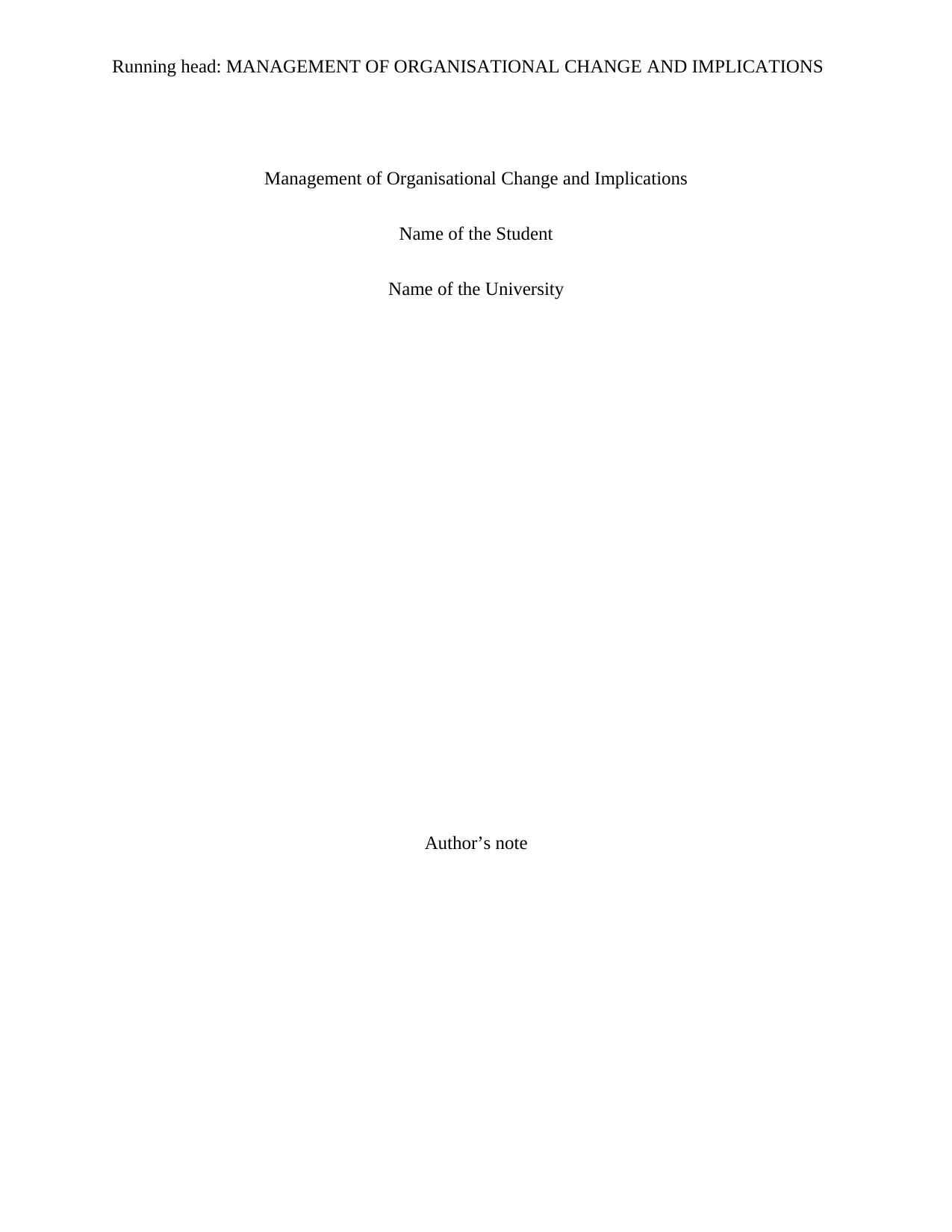
Running head: MANAGEMENT OF ORGANISATIONAL CHANGE AND IMPLICATIONS
Management of Organisational Change and Implications
Name of the Student
Name of the University
Author’s note
Management of Organisational Change and Implications
Name of the Student
Name of the University
Author’s note
Secure Best Marks with AI Grader
Need help grading? Try our AI Grader for instant feedback on your assignments.
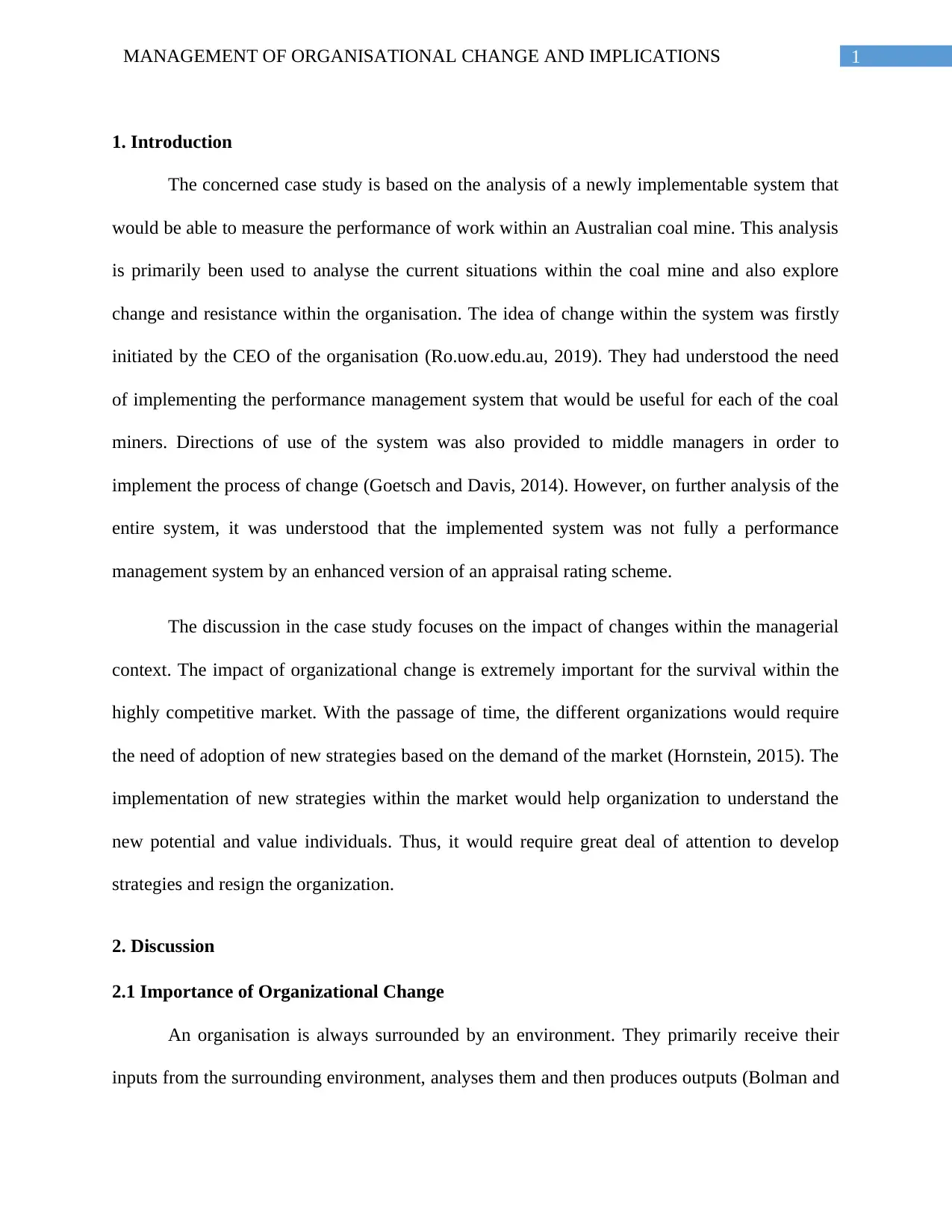
1MANAGEMENT OF ORGANISATIONAL CHANGE AND IMPLICATIONS
1. Introduction
The concerned case study is based on the analysis of a newly implementable system that
would be able to measure the performance of work within an Australian coal mine. This analysis
is primarily been used to analyse the current situations within the coal mine and also explore
change and resistance within the organisation. The idea of change within the system was firstly
initiated by the CEO of the organisation (Ro.uow.edu.au, 2019). They had understood the need
of implementing the performance management system that would be useful for each of the coal
miners. Directions of use of the system was also provided to middle managers in order to
implement the process of change (Goetsch and Davis, 2014). However, on further analysis of the
entire system, it was understood that the implemented system was not fully a performance
management system by an enhanced version of an appraisal rating scheme.
The discussion in the case study focuses on the impact of changes within the managerial
context. The impact of organizational change is extremely important for the survival within the
highly competitive market. With the passage of time, the different organizations would require
the need of adoption of new strategies based on the demand of the market (Hornstein, 2015). The
implementation of new strategies within the market would help organization to understand the
new potential and value individuals. Thus, it would require great deal of attention to develop
strategies and resign the organization.
2. Discussion
2.1 Importance of Organizational Change
An organisation is always surrounded by an environment. They primarily receive their
inputs from the surrounding environment, analyses them and then produces outputs (Bolman and
1. Introduction
The concerned case study is based on the analysis of a newly implementable system that
would be able to measure the performance of work within an Australian coal mine. This analysis
is primarily been used to analyse the current situations within the coal mine and also explore
change and resistance within the organisation. The idea of change within the system was firstly
initiated by the CEO of the organisation (Ro.uow.edu.au, 2019). They had understood the need
of implementing the performance management system that would be useful for each of the coal
miners. Directions of use of the system was also provided to middle managers in order to
implement the process of change (Goetsch and Davis, 2014). However, on further analysis of the
entire system, it was understood that the implemented system was not fully a performance
management system by an enhanced version of an appraisal rating scheme.
The discussion in the case study focuses on the impact of changes within the managerial
context. The impact of organizational change is extremely important for the survival within the
highly competitive market. With the passage of time, the different organizations would require
the need of adoption of new strategies based on the demand of the market (Hornstein, 2015). The
implementation of new strategies within the market would help organization to understand the
new potential and value individuals. Thus, it would require great deal of attention to develop
strategies and resign the organization.
2. Discussion
2.1 Importance of Organizational Change
An organisation is always surrounded by an environment. They primarily receive their
inputs from the surrounding environment, analyses them and then produces outputs (Bolman and
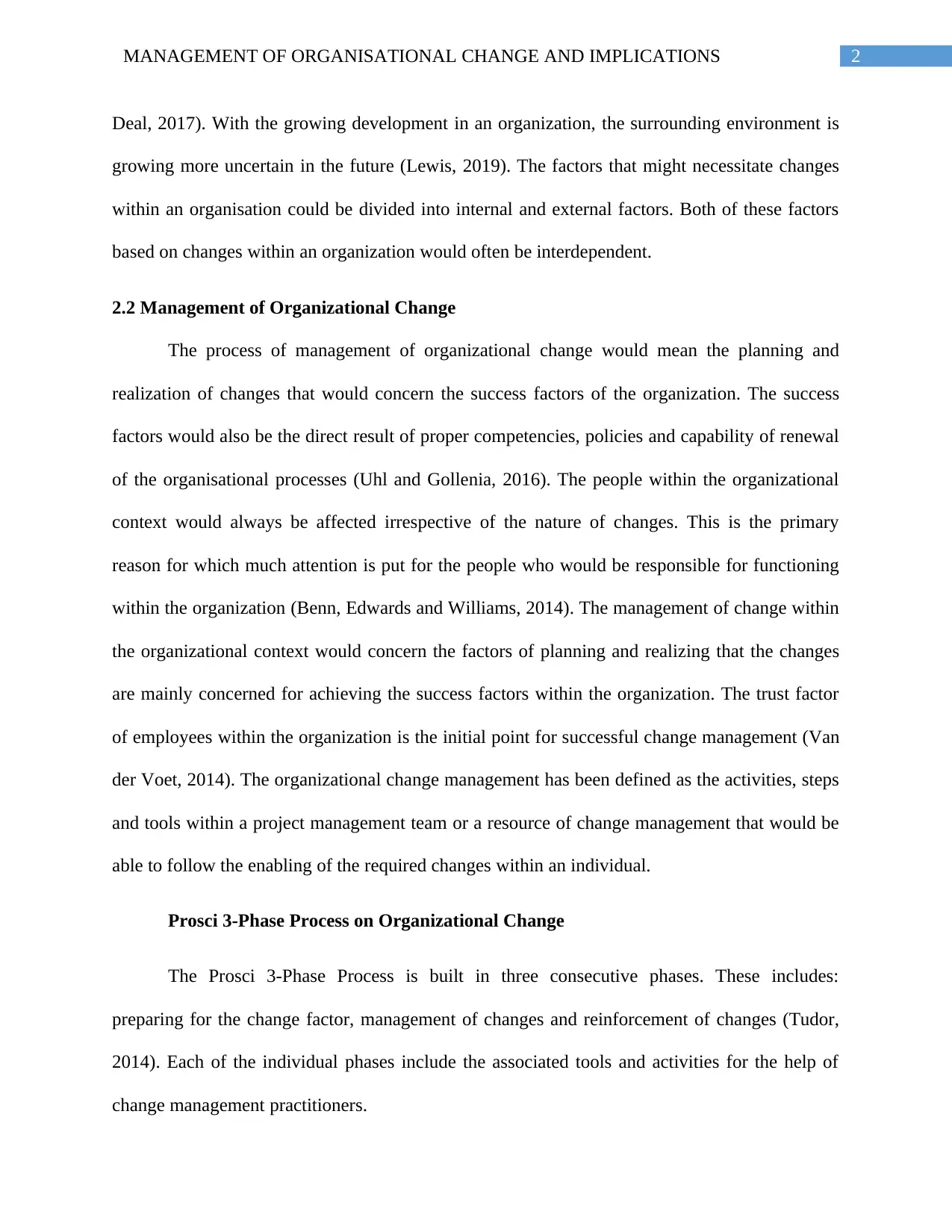
2MANAGEMENT OF ORGANISATIONAL CHANGE AND IMPLICATIONS
Deal, 2017). With the growing development in an organization, the surrounding environment is
growing more uncertain in the future (Lewis, 2019). The factors that might necessitate changes
within an organisation could be divided into internal and external factors. Both of these factors
based on changes within an organization would often be interdependent.
2.2 Management of Organizational Change
The process of management of organizational change would mean the planning and
realization of changes that would concern the success factors of the organization. The success
factors would also be the direct result of proper competencies, policies and capability of renewal
of the organisational processes (Uhl and Gollenia, 2016). The people within the organizational
context would always be affected irrespective of the nature of changes. This is the primary
reason for which much attention is put for the people who would be responsible for functioning
within the organization (Benn, Edwards and Williams, 2014). The management of change within
the organizational context would concern the factors of planning and realizing that the changes
are mainly concerned for achieving the success factors within the organization. The trust factor
of employees within the organization is the initial point for successful change management (Van
der Voet, 2014). The organizational change management has been defined as the activities, steps
and tools within a project management team or a resource of change management that would be
able to follow the enabling of the required changes within an individual.
Prosci 3-Phase Process on Organizational Change
The Prosci 3-Phase Process is built in three consecutive phases. These includes:
preparing for the change factor, management of changes and reinforcement of changes (Tudor,
2014). Each of the individual phases include the associated tools and activities for the help of
change management practitioners.
Deal, 2017). With the growing development in an organization, the surrounding environment is
growing more uncertain in the future (Lewis, 2019). The factors that might necessitate changes
within an organisation could be divided into internal and external factors. Both of these factors
based on changes within an organization would often be interdependent.
2.2 Management of Organizational Change
The process of management of organizational change would mean the planning and
realization of changes that would concern the success factors of the organization. The success
factors would also be the direct result of proper competencies, policies and capability of renewal
of the organisational processes (Uhl and Gollenia, 2016). The people within the organizational
context would always be affected irrespective of the nature of changes. This is the primary
reason for which much attention is put for the people who would be responsible for functioning
within the organization (Benn, Edwards and Williams, 2014). The management of change within
the organizational context would concern the factors of planning and realizing that the changes
are mainly concerned for achieving the success factors within the organization. The trust factor
of employees within the organization is the initial point for successful change management (Van
der Voet, 2014). The organizational change management has been defined as the activities, steps
and tools within a project management team or a resource of change management that would be
able to follow the enabling of the required changes within an individual.
Prosci 3-Phase Process on Organizational Change
The Prosci 3-Phase Process is built in three consecutive phases. These includes:
preparing for the change factor, management of changes and reinforcement of changes (Tudor,
2014). Each of the individual phases include the associated tools and activities for the help of
change management practitioners.
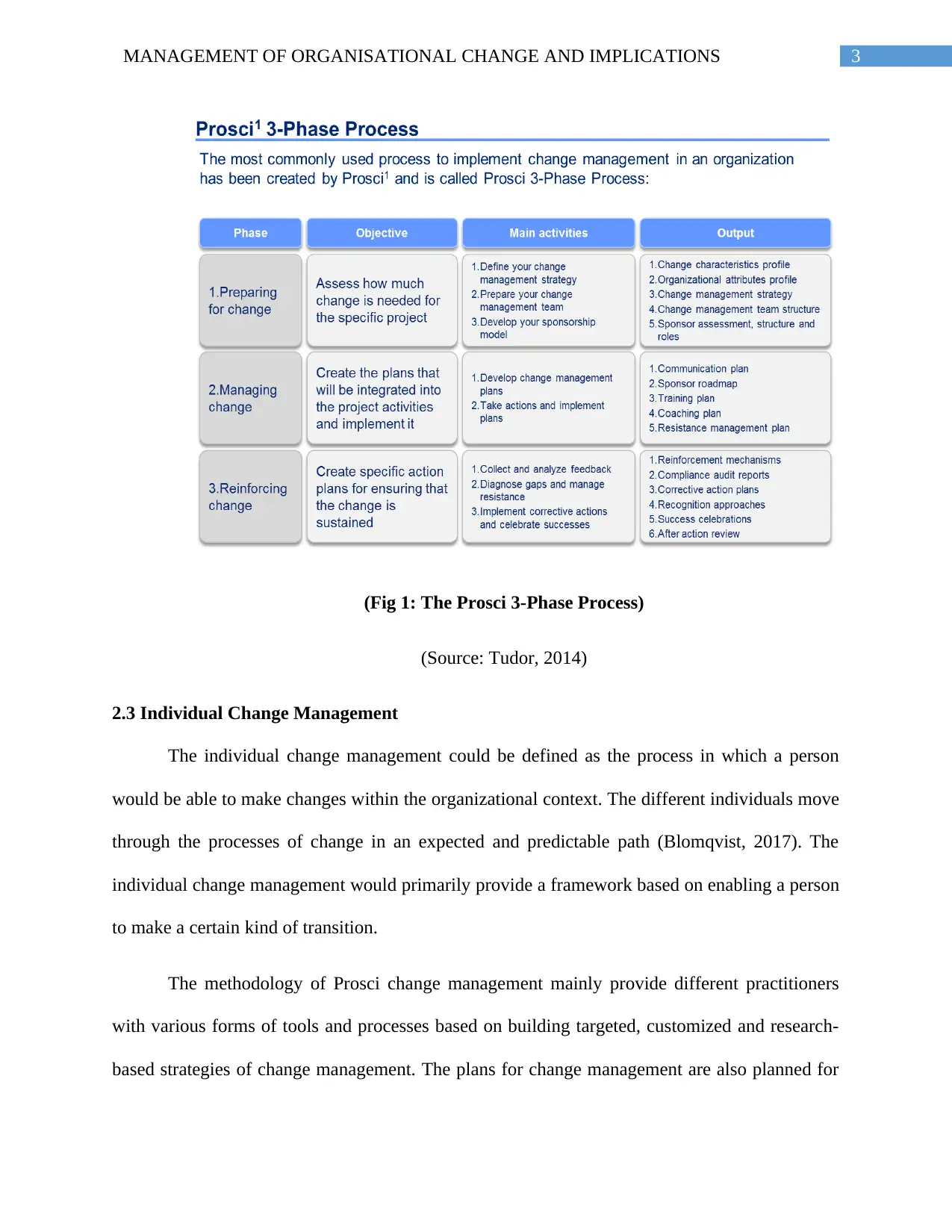
3MANAGEMENT OF ORGANISATIONAL CHANGE AND IMPLICATIONS
(Fig 1: The Prosci 3-Phase Process)
(Source: Tudor, 2014)
2.3 Individual Change Management
The individual change management could be defined as the process in which a person
would be able to make changes within the organizational context. The different individuals move
through the processes of change in an expected and predictable path (Blomqvist, 2017). The
individual change management would primarily provide a framework based on enabling a person
to make a certain kind of transition.
The methodology of Prosci change management mainly provide different practitioners
with various forms of tools and processes based on building targeted, customized and research-
based strategies of change management. The plans for change management are also planned for
(Fig 1: The Prosci 3-Phase Process)
(Source: Tudor, 2014)
2.3 Individual Change Management
The individual change management could be defined as the process in which a person
would be able to make changes within the organizational context. The different individuals move
through the processes of change in an expected and predictable path (Blomqvist, 2017). The
individual change management would primarily provide a framework based on enabling a person
to make a certain kind of transition.
The methodology of Prosci change management mainly provide different practitioners
with various forms of tools and processes based on building targeted, customized and research-
based strategies of change management. The plans for change management are also planned for
Secure Best Marks with AI Grader
Need help grading? Try our AI Grader for instant feedback on your assignments.
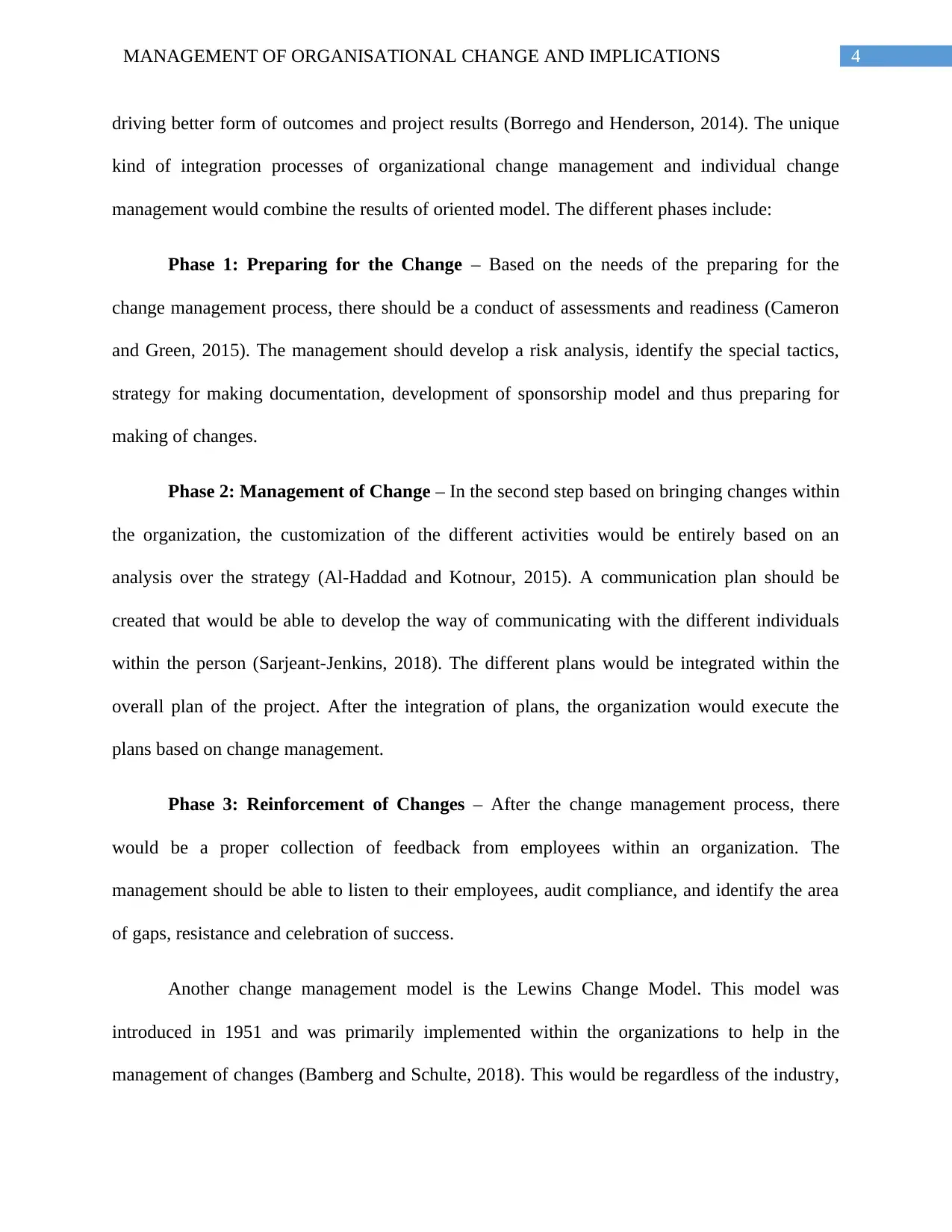
4MANAGEMENT OF ORGANISATIONAL CHANGE AND IMPLICATIONS
driving better form of outcomes and project results (Borrego and Henderson, 2014). The unique
kind of integration processes of organizational change management and individual change
management would combine the results of oriented model. The different phases include:
Phase 1: Preparing for the Change – Based on the needs of the preparing for the
change management process, there should be a conduct of assessments and readiness (Cameron
and Green, 2015). The management should develop a risk analysis, identify the special tactics,
strategy for making documentation, development of sponsorship model and thus preparing for
making of changes.
Phase 2: Management of Change – In the second step based on bringing changes within
the organization, the customization of the different activities would be entirely based on an
analysis over the strategy (Al-Haddad and Kotnour, 2015). A communication plan should be
created that would be able to develop the way of communicating with the different individuals
within the person (Sarjeant-Jenkins, 2018). The different plans would be integrated within the
overall plan of the project. After the integration of plans, the organization would execute the
plans based on change management.
Phase 3: Reinforcement of Changes – After the change management process, there
would be a proper collection of feedback from employees within an organization. The
management should be able to listen to their employees, audit compliance, and identify the area
of gaps, resistance and celebration of success.
Another change management model is the Lewins Change Model. This model was
introduced in 1951 and was primarily implemented within the organizations to help in the
management of changes (Bamberg and Schulte, 2018). This would be regardless of the industry,
driving better form of outcomes and project results (Borrego and Henderson, 2014). The unique
kind of integration processes of organizational change management and individual change
management would combine the results of oriented model. The different phases include:
Phase 1: Preparing for the Change – Based on the needs of the preparing for the
change management process, there should be a conduct of assessments and readiness (Cameron
and Green, 2015). The management should develop a risk analysis, identify the special tactics,
strategy for making documentation, development of sponsorship model and thus preparing for
making of changes.
Phase 2: Management of Change – In the second step based on bringing changes within
the organization, the customization of the different activities would be entirely based on an
analysis over the strategy (Al-Haddad and Kotnour, 2015). A communication plan should be
created that would be able to develop the way of communicating with the different individuals
within the person (Sarjeant-Jenkins, 2018). The different plans would be integrated within the
overall plan of the project. After the integration of plans, the organization would execute the
plans based on change management.
Phase 3: Reinforcement of Changes – After the change management process, there
would be a proper collection of feedback from employees within an organization. The
management should be able to listen to their employees, audit compliance, and identify the area
of gaps, resistance and celebration of success.
Another change management model is the Lewins Change Model. This model was
introduced in 1951 and was primarily implemented within the organizations to help in the
management of changes (Bamberg and Schulte, 2018). This would be regardless of the industry,
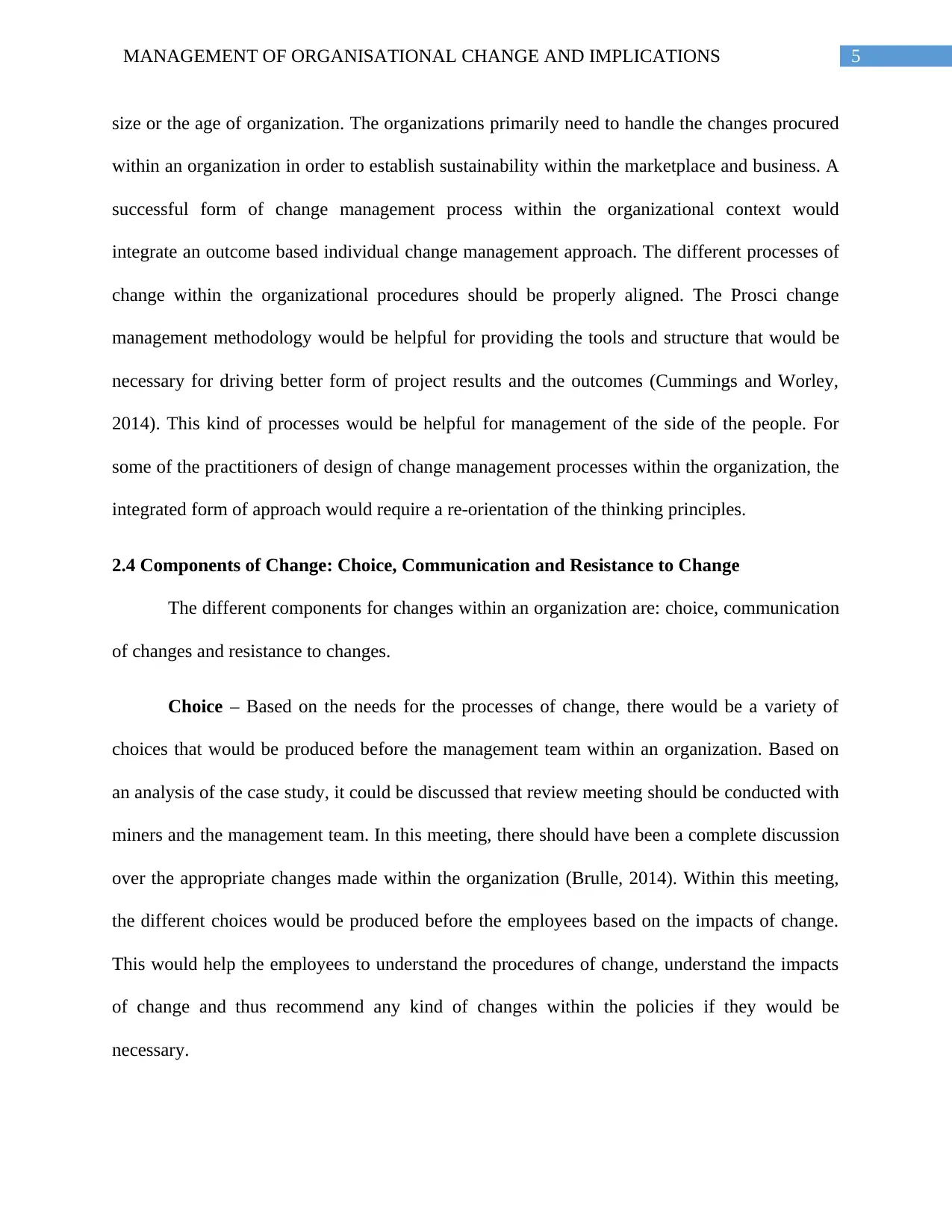
5MANAGEMENT OF ORGANISATIONAL CHANGE AND IMPLICATIONS
size or the age of organization. The organizations primarily need to handle the changes procured
within an organization in order to establish sustainability within the marketplace and business. A
successful form of change management process within the organizational context would
integrate an outcome based individual change management approach. The different processes of
change within the organizational procedures should be properly aligned. The Prosci change
management methodology would be helpful for providing the tools and structure that would be
necessary for driving better form of project results and the outcomes (Cummings and Worley,
2014). This kind of processes would be helpful for management of the side of the people. For
some of the practitioners of design of change management processes within the organization, the
integrated form of approach would require a re-orientation of the thinking principles.
2.4 Components of Change: Choice, Communication and Resistance to Change
The different components for changes within an organization are: choice, communication
of changes and resistance to changes.
Choice – Based on the needs for the processes of change, there would be a variety of
choices that would be produced before the management team within an organization. Based on
an analysis of the case study, it could be discussed that review meeting should be conducted with
miners and the management team. In this meeting, there should have been a complete discussion
over the appropriate changes made within the organization (Brulle, 2014). Within this meeting,
the different choices would be produced before the employees based on the impacts of change.
This would help the employees to understand the procedures of change, understand the impacts
of change and thus recommend any kind of changes within the policies if they would be
necessary.
size or the age of organization. The organizations primarily need to handle the changes procured
within an organization in order to establish sustainability within the marketplace and business. A
successful form of change management process within the organizational context would
integrate an outcome based individual change management approach. The different processes of
change within the organizational procedures should be properly aligned. The Prosci change
management methodology would be helpful for providing the tools and structure that would be
necessary for driving better form of project results and the outcomes (Cummings and Worley,
2014). This kind of processes would be helpful for management of the side of the people. For
some of the practitioners of design of change management processes within the organization, the
integrated form of approach would require a re-orientation of the thinking principles.
2.4 Components of Change: Choice, Communication and Resistance to Change
The different components for changes within an organization are: choice, communication
of changes and resistance to changes.
Choice – Based on the needs for the processes of change, there would be a variety of
choices that would be produced before the management team within an organization. Based on
an analysis of the case study, it could be discussed that review meeting should be conducted with
miners and the management team. In this meeting, there should have been a complete discussion
over the appropriate changes made within the organization (Brulle, 2014). Within this meeting,
the different choices would be produced before the employees based on the impacts of change.
This would help the employees to understand the procedures of change, understand the impacts
of change and thus recommend any kind of changes within the policies if they would be
necessary.
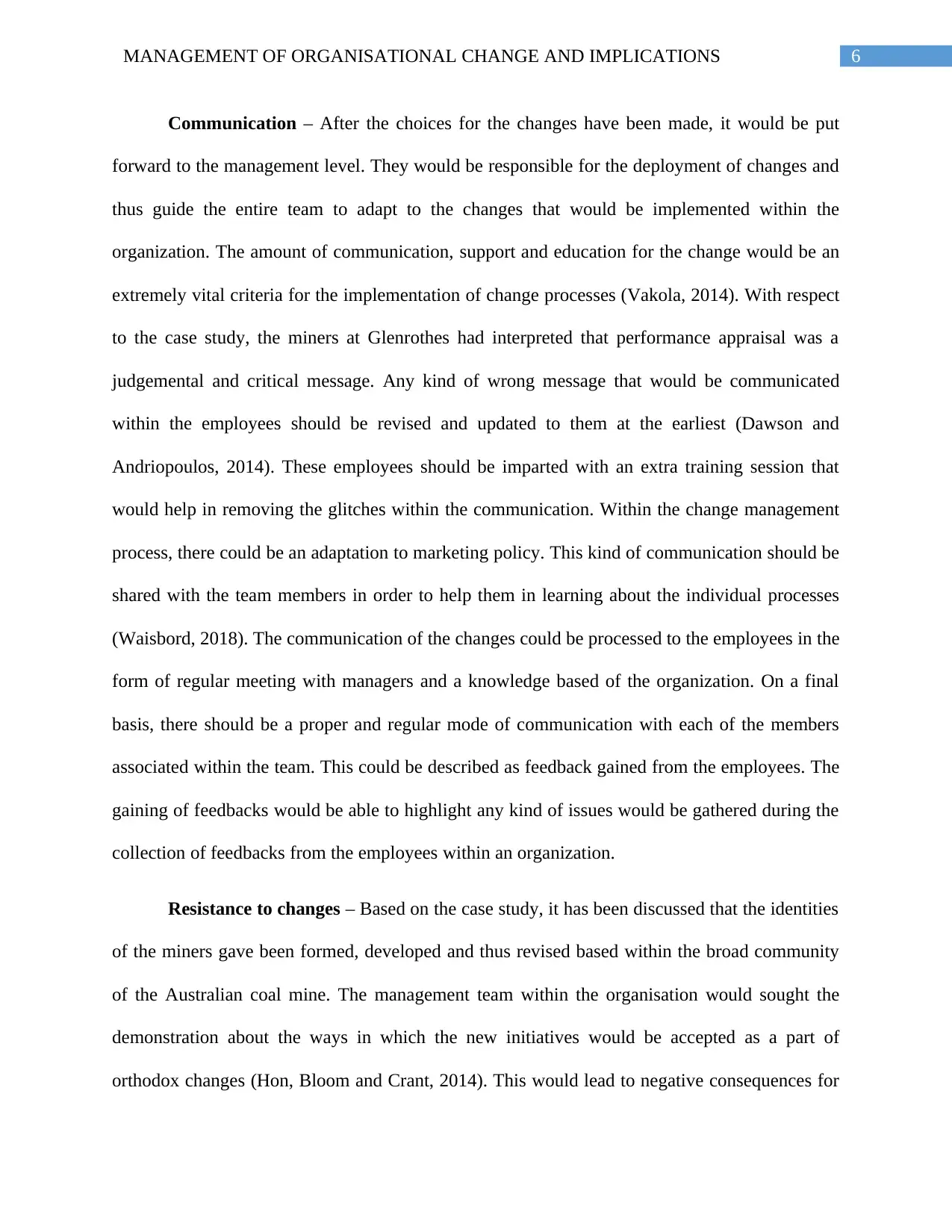
6MANAGEMENT OF ORGANISATIONAL CHANGE AND IMPLICATIONS
Communication – After the choices for the changes have been made, it would be put
forward to the management level. They would be responsible for the deployment of changes and
thus guide the entire team to adapt to the changes that would be implemented within the
organization. The amount of communication, support and education for the change would be an
extremely vital criteria for the implementation of change processes (Vakola, 2014). With respect
to the case study, the miners at Glenrothes had interpreted that performance appraisal was a
judgemental and critical message. Any kind of wrong message that would be communicated
within the employees should be revised and updated to them at the earliest (Dawson and
Andriopoulos, 2014). These employees should be imparted with an extra training session that
would help in removing the glitches within the communication. Within the change management
process, there could be an adaptation to marketing policy. This kind of communication should be
shared with the team members in order to help them in learning about the individual processes
(Waisbord, 2018). The communication of the changes could be processed to the employees in the
form of regular meeting with managers and a knowledge based of the organization. On a final
basis, there should be a proper and regular mode of communication with each of the members
associated within the team. This could be described as feedback gained from the employees. The
gaining of feedbacks would be able to highlight any kind of issues would be gathered during the
collection of feedbacks from the employees within an organization.
Resistance to changes – Based on the case study, it has been discussed that the identities
of the miners gave been formed, developed and thus revised based within the broad community
of the Australian coal mine. The management team within the organisation would sought the
demonstration about the ways in which the new initiatives would be accepted as a part of
orthodox changes (Hon, Bloom and Crant, 2014). This would lead to negative consequences for
Communication – After the choices for the changes have been made, it would be put
forward to the management level. They would be responsible for the deployment of changes and
thus guide the entire team to adapt to the changes that would be implemented within the
organization. The amount of communication, support and education for the change would be an
extremely vital criteria for the implementation of change processes (Vakola, 2014). With respect
to the case study, the miners at Glenrothes had interpreted that performance appraisal was a
judgemental and critical message. Any kind of wrong message that would be communicated
within the employees should be revised and updated to them at the earliest (Dawson and
Andriopoulos, 2014). These employees should be imparted with an extra training session that
would help in removing the glitches within the communication. Within the change management
process, there could be an adaptation to marketing policy. This kind of communication should be
shared with the team members in order to help them in learning about the individual processes
(Waisbord, 2018). The communication of the changes could be processed to the employees in the
form of regular meeting with managers and a knowledge based of the organization. On a final
basis, there should be a proper and regular mode of communication with each of the members
associated within the team. This could be described as feedback gained from the employees. The
gaining of feedbacks would be able to highlight any kind of issues would be gathered during the
collection of feedbacks from the employees within an organization.
Resistance to changes – Based on the case study, it has been discussed that the identities
of the miners gave been formed, developed and thus revised based within the broad community
of the Australian coal mine. The management team within the organisation would sought the
demonstration about the ways in which the new initiatives would be accepted as a part of
orthodox changes (Hon, Bloom and Crant, 2014). This would lead to negative consequences for
Paraphrase This Document
Need a fresh take? Get an instant paraphrase of this document with our AI Paraphraser
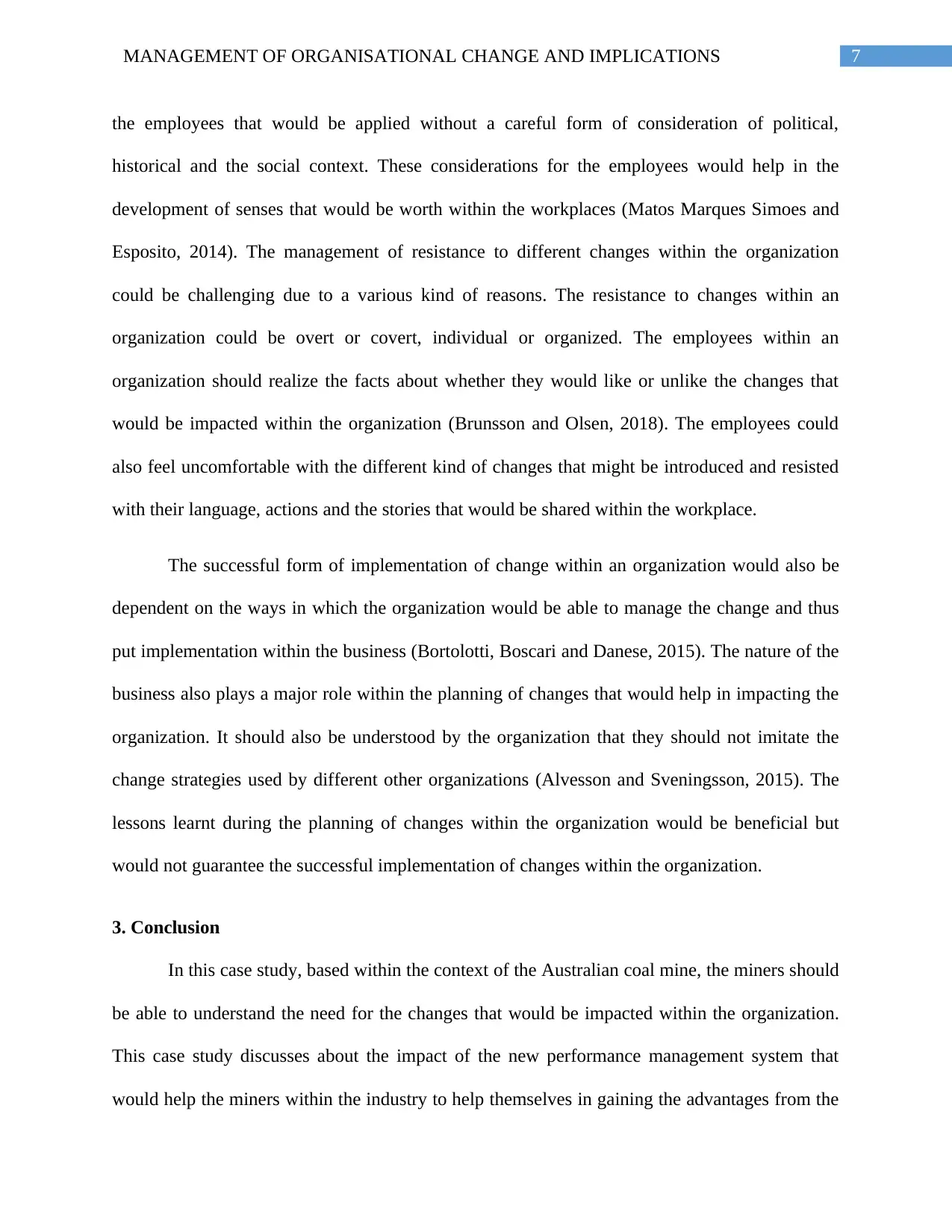
7MANAGEMENT OF ORGANISATIONAL CHANGE AND IMPLICATIONS
the employees that would be applied without a careful form of consideration of political,
historical and the social context. These considerations for the employees would help in the
development of senses that would be worth within the workplaces (Matos Marques Simoes and
Esposito, 2014). The management of resistance to different changes within the organization
could be challenging due to a various kind of reasons. The resistance to changes within an
organization could be overt or covert, individual or organized. The employees within an
organization should realize the facts about whether they would like or unlike the changes that
would be impacted within the organization (Brunsson and Olsen, 2018). The employees could
also feel uncomfortable with the different kind of changes that might be introduced and resisted
with their language, actions and the stories that would be shared within the workplace.
The successful form of implementation of change within an organization would also be
dependent on the ways in which the organization would be able to manage the change and thus
put implementation within the business (Bortolotti, Boscari and Danese, 2015). The nature of the
business also plays a major role within the planning of changes that would help in impacting the
organization. It should also be understood by the organization that they should not imitate the
change strategies used by different other organizations (Alvesson and Sveningsson, 2015). The
lessons learnt during the planning of changes within the organization would be beneficial but
would not guarantee the successful implementation of changes within the organization.
3. Conclusion
In this case study, based within the context of the Australian coal mine, the miners should
be able to understand the need for the changes that would be impacted within the organization.
This case study discusses about the impact of the new performance management system that
would help the miners within the industry to help themselves in gaining the advantages from the
the employees that would be applied without a careful form of consideration of political,
historical and the social context. These considerations for the employees would help in the
development of senses that would be worth within the workplaces (Matos Marques Simoes and
Esposito, 2014). The management of resistance to different changes within the organization
could be challenging due to a various kind of reasons. The resistance to changes within an
organization could be overt or covert, individual or organized. The employees within an
organization should realize the facts about whether they would like or unlike the changes that
would be impacted within the organization (Brunsson and Olsen, 2018). The employees could
also feel uncomfortable with the different kind of changes that might be introduced and resisted
with their language, actions and the stories that would be shared within the workplace.
The successful form of implementation of change within an organization would also be
dependent on the ways in which the organization would be able to manage the change and thus
put implementation within the business (Bortolotti, Boscari and Danese, 2015). The nature of the
business also plays a major role within the planning of changes that would help in impacting the
organization. It should also be understood by the organization that they should not imitate the
change strategies used by different other organizations (Alvesson and Sveningsson, 2015). The
lessons learnt during the planning of changes within the organization would be beneficial but
would not guarantee the successful implementation of changes within the organization.
3. Conclusion
In this case study, based within the context of the Australian coal mine, the miners should
be able to understand the need for the changes that would be impacted within the organization.
This case study discusses about the impact of the new performance management system that
would help the miners within the industry to help themselves in gaining the advantages from the
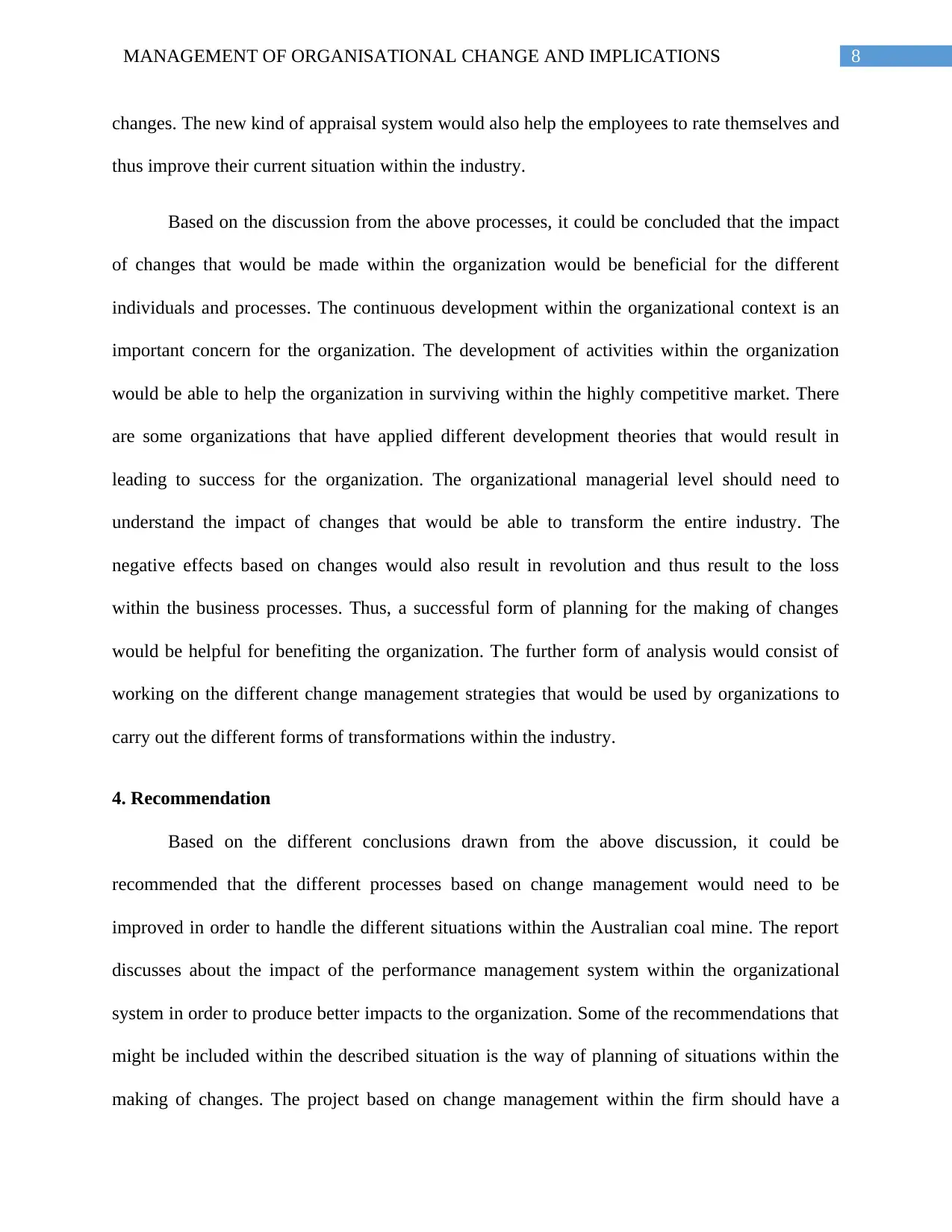
8MANAGEMENT OF ORGANISATIONAL CHANGE AND IMPLICATIONS
changes. The new kind of appraisal system would also help the employees to rate themselves and
thus improve their current situation within the industry.
Based on the discussion from the above processes, it could be concluded that the impact
of changes that would be made within the organization would be beneficial for the different
individuals and processes. The continuous development within the organizational context is an
important concern for the organization. The development of activities within the organization
would be able to help the organization in surviving within the highly competitive market. There
are some organizations that have applied different development theories that would result in
leading to success for the organization. The organizational managerial level should need to
understand the impact of changes that would be able to transform the entire industry. The
negative effects based on changes would also result in revolution and thus result to the loss
within the business processes. Thus, a successful form of planning for the making of changes
would be helpful for benefiting the organization. The further form of analysis would consist of
working on the different change management strategies that would be used by organizations to
carry out the different forms of transformations within the industry.
4. Recommendation
Based on the different conclusions drawn from the above discussion, it could be
recommended that the different processes based on change management would need to be
improved in order to handle the different situations within the Australian coal mine. The report
discusses about the impact of the performance management system within the organizational
system in order to produce better impacts to the organization. Some of the recommendations that
might be included within the described situation is the way of planning of situations within the
making of changes. The project based on change management within the firm should have a
changes. The new kind of appraisal system would also help the employees to rate themselves and
thus improve their current situation within the industry.
Based on the discussion from the above processes, it could be concluded that the impact
of changes that would be made within the organization would be beneficial for the different
individuals and processes. The continuous development within the organizational context is an
important concern for the organization. The development of activities within the organization
would be able to help the organization in surviving within the highly competitive market. There
are some organizations that have applied different development theories that would result in
leading to success for the organization. The organizational managerial level should need to
understand the impact of changes that would be able to transform the entire industry. The
negative effects based on changes would also result in revolution and thus result to the loss
within the business processes. Thus, a successful form of planning for the making of changes
would be helpful for benefiting the organization. The further form of analysis would consist of
working on the different change management strategies that would be used by organizations to
carry out the different forms of transformations within the industry.
4. Recommendation
Based on the different conclusions drawn from the above discussion, it could be
recommended that the different processes based on change management would need to be
improved in order to handle the different situations within the Australian coal mine. The report
discusses about the impact of the performance management system within the organizational
system in order to produce better impacts to the organization. Some of the recommendations that
might be included within the described situation is the way of planning of situations within the
making of changes. The project based on change management within the firm should have a
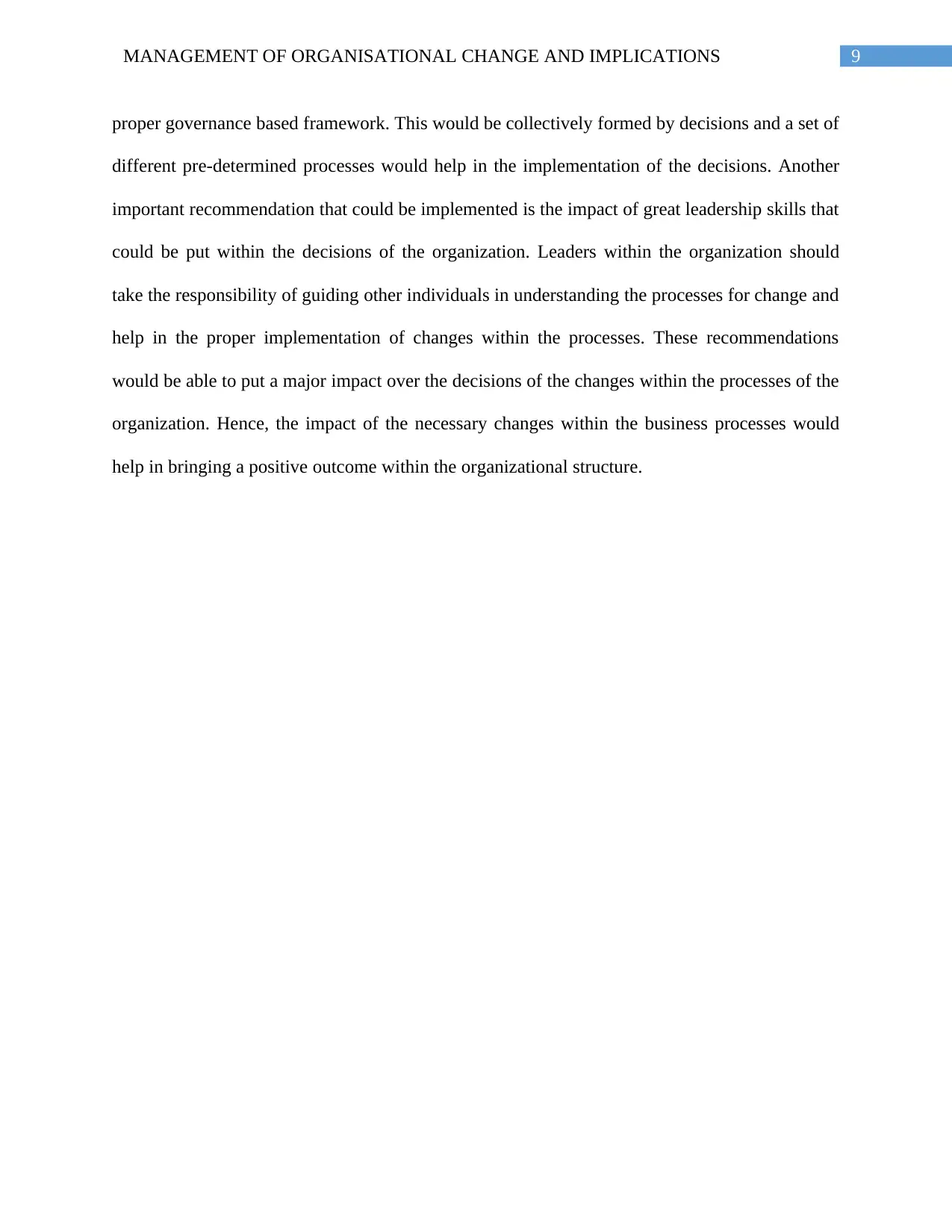
9MANAGEMENT OF ORGANISATIONAL CHANGE AND IMPLICATIONS
proper governance based framework. This would be collectively formed by decisions and a set of
different pre-determined processes would help in the implementation of the decisions. Another
important recommendation that could be implemented is the impact of great leadership skills that
could be put within the decisions of the organization. Leaders within the organization should
take the responsibility of guiding other individuals in understanding the processes for change and
help in the proper implementation of changes within the processes. These recommendations
would be able to put a major impact over the decisions of the changes within the processes of the
organization. Hence, the impact of the necessary changes within the business processes would
help in bringing a positive outcome within the organizational structure.
proper governance based framework. This would be collectively formed by decisions and a set of
different pre-determined processes would help in the implementation of the decisions. Another
important recommendation that could be implemented is the impact of great leadership skills that
could be put within the decisions of the organization. Leaders within the organization should
take the responsibility of guiding other individuals in understanding the processes for change and
help in the proper implementation of changes within the processes. These recommendations
would be able to put a major impact over the decisions of the changes within the processes of the
organization. Hence, the impact of the necessary changes within the business processes would
help in bringing a positive outcome within the organizational structure.
Secure Best Marks with AI Grader
Need help grading? Try our AI Grader for instant feedback on your assignments.
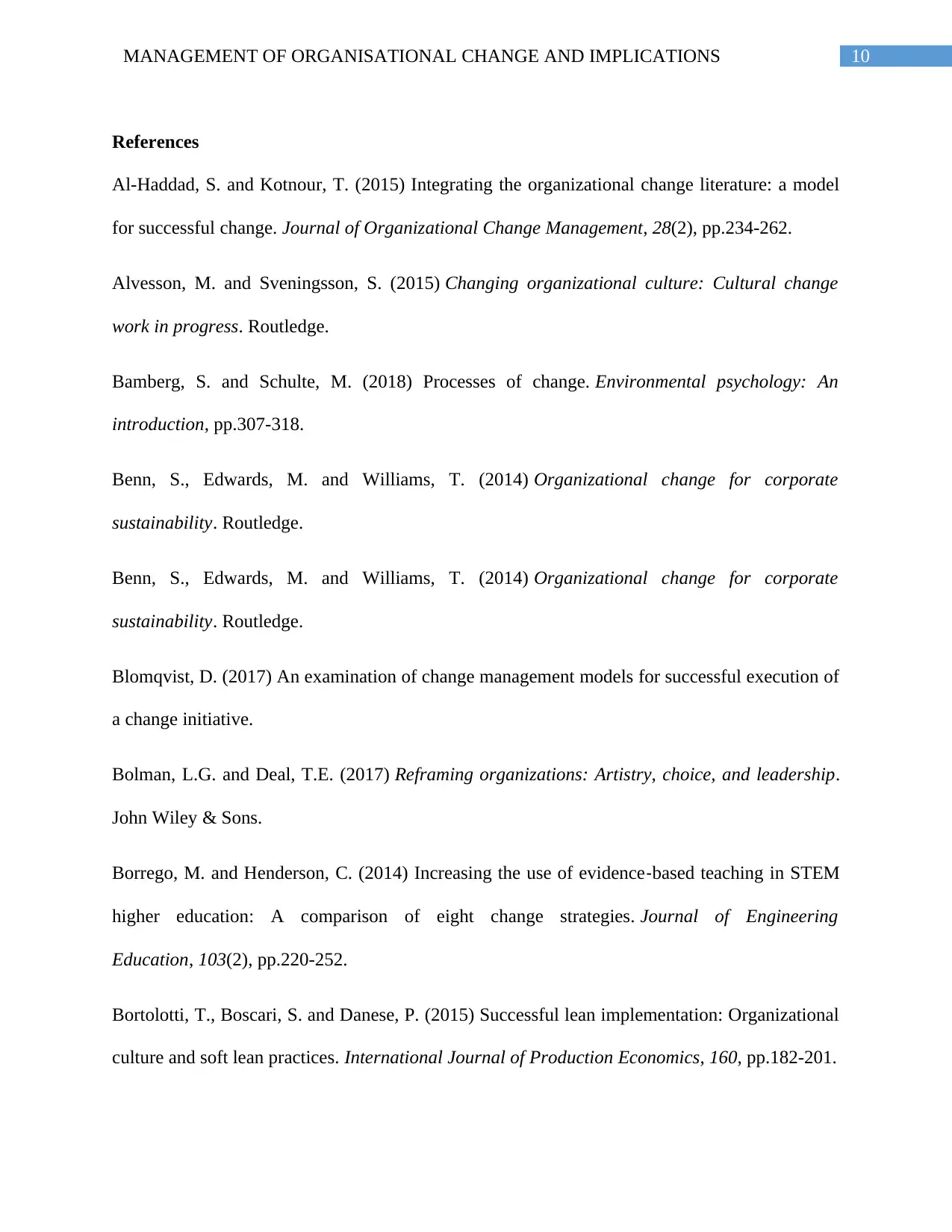
10MANAGEMENT OF ORGANISATIONAL CHANGE AND IMPLICATIONS
References
Al-Haddad, S. and Kotnour, T. (2015) Integrating the organizational change literature: a model
for successful change. Journal of Organizational Change Management, 28(2), pp.234-262.
Alvesson, M. and Sveningsson, S. (2015) Changing organizational culture: Cultural change
work in progress. Routledge.
Bamberg, S. and Schulte, M. (2018) Processes of change. Environmental psychology: An
introduction, pp.307-318.
Benn, S., Edwards, M. and Williams, T. (2014) Organizational change for corporate
sustainability. Routledge.
Benn, S., Edwards, M. and Williams, T. (2014) Organizational change for corporate
sustainability. Routledge.
Blomqvist, D. (2017) An examination of change management models for successful execution of
a change initiative.
Bolman, L.G. and Deal, T.E. (2017) Reframing organizations: Artistry, choice, and leadership.
John Wiley & Sons.
Borrego, M. and Henderson, C. (2014) Increasing the use of evidence‐based teaching in STEM
higher education: A comparison of eight change strategies. Journal of Engineering
Education, 103(2), pp.220-252.
Bortolotti, T., Boscari, S. and Danese, P. (2015) Successful lean implementation: Organizational
culture and soft lean practices. International Journal of Production Economics, 160, pp.182-201.
References
Al-Haddad, S. and Kotnour, T. (2015) Integrating the organizational change literature: a model
for successful change. Journal of Organizational Change Management, 28(2), pp.234-262.
Alvesson, M. and Sveningsson, S. (2015) Changing organizational culture: Cultural change
work in progress. Routledge.
Bamberg, S. and Schulte, M. (2018) Processes of change. Environmental psychology: An
introduction, pp.307-318.
Benn, S., Edwards, M. and Williams, T. (2014) Organizational change for corporate
sustainability. Routledge.
Benn, S., Edwards, M. and Williams, T. (2014) Organizational change for corporate
sustainability. Routledge.
Blomqvist, D. (2017) An examination of change management models for successful execution of
a change initiative.
Bolman, L.G. and Deal, T.E. (2017) Reframing organizations: Artistry, choice, and leadership.
John Wiley & Sons.
Borrego, M. and Henderson, C. (2014) Increasing the use of evidence‐based teaching in STEM
higher education: A comparison of eight change strategies. Journal of Engineering
Education, 103(2), pp.220-252.
Bortolotti, T., Boscari, S. and Danese, P. (2015) Successful lean implementation: Organizational
culture and soft lean practices. International Journal of Production Economics, 160, pp.182-201.
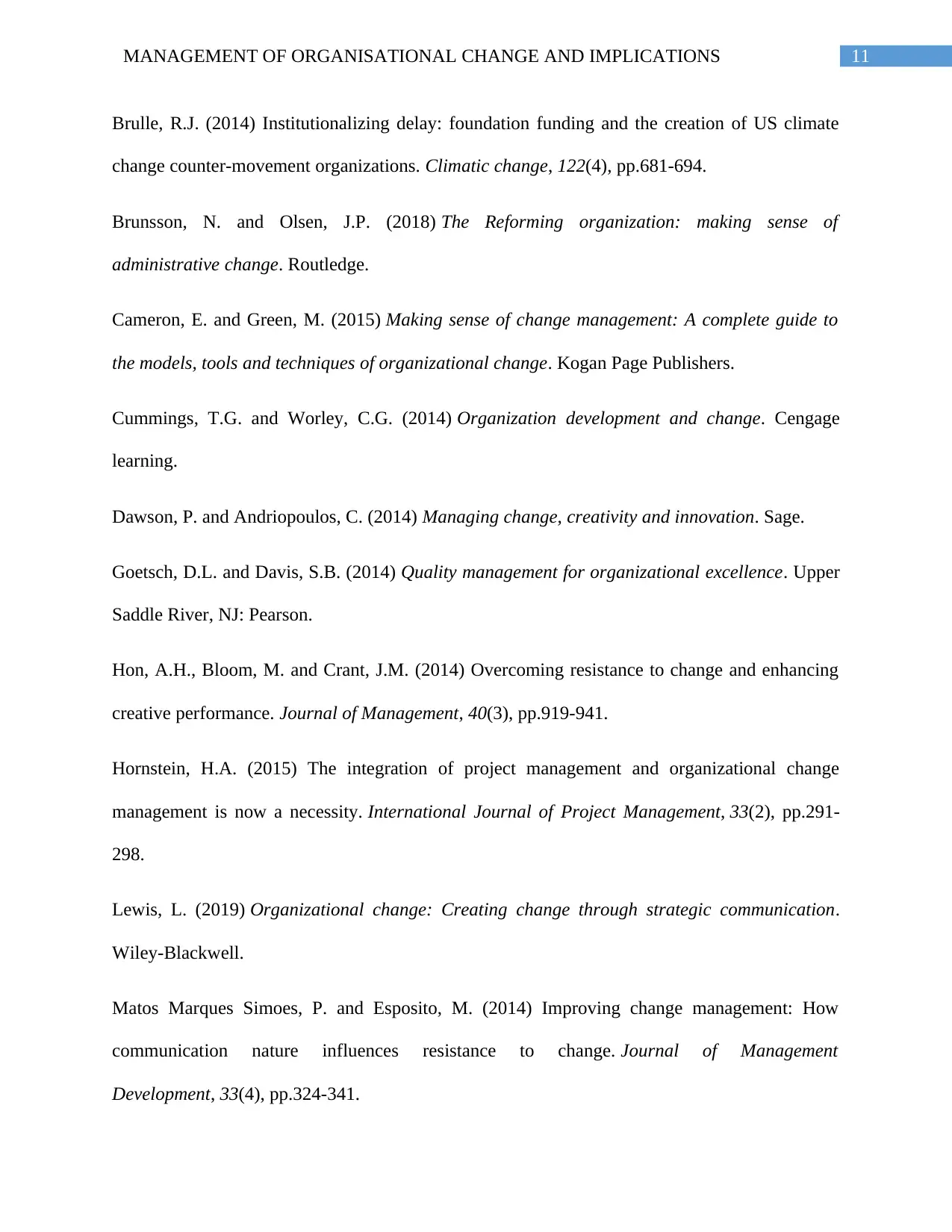
11MANAGEMENT OF ORGANISATIONAL CHANGE AND IMPLICATIONS
Brulle, R.J. (2014) Institutionalizing delay: foundation funding and the creation of US climate
change counter-movement organizations. Climatic change, 122(4), pp.681-694.
Brunsson, N. and Olsen, J.P. (2018) The Reforming organization: making sense of
administrative change. Routledge.
Cameron, E. and Green, M. (2015) Making sense of change management: A complete guide to
the models, tools and techniques of organizational change. Kogan Page Publishers.
Cummings, T.G. and Worley, C.G. (2014) Organization development and change. Cengage
learning.
Dawson, P. and Andriopoulos, C. (2014) Managing change, creativity and innovation. Sage.
Goetsch, D.L. and Davis, S.B. (2014) Quality management for organizational excellence. Upper
Saddle River, NJ: Pearson.
Hon, A.H., Bloom, M. and Crant, J.M. (2014) Overcoming resistance to change and enhancing
creative performance. Journal of Management, 40(3), pp.919-941.
Hornstein, H.A. (2015) The integration of project management and organizational change
management is now a necessity. International Journal of Project Management, 33(2), pp.291-
298.
Lewis, L. (2019) Organizational change: Creating change through strategic communication.
Wiley-Blackwell.
Matos Marques Simoes, P. and Esposito, M. (2014) Improving change management: How
communication nature influences resistance to change. Journal of Management
Development, 33(4), pp.324-341.
Brulle, R.J. (2014) Institutionalizing delay: foundation funding and the creation of US climate
change counter-movement organizations. Climatic change, 122(4), pp.681-694.
Brunsson, N. and Olsen, J.P. (2018) The Reforming organization: making sense of
administrative change. Routledge.
Cameron, E. and Green, M. (2015) Making sense of change management: A complete guide to
the models, tools and techniques of organizational change. Kogan Page Publishers.
Cummings, T.G. and Worley, C.G. (2014) Organization development and change. Cengage
learning.
Dawson, P. and Andriopoulos, C. (2014) Managing change, creativity and innovation. Sage.
Goetsch, D.L. and Davis, S.B. (2014) Quality management for organizational excellence. Upper
Saddle River, NJ: Pearson.
Hon, A.H., Bloom, M. and Crant, J.M. (2014) Overcoming resistance to change and enhancing
creative performance. Journal of Management, 40(3), pp.919-941.
Hornstein, H.A. (2015) The integration of project management and organizational change
management is now a necessity. International Journal of Project Management, 33(2), pp.291-
298.
Lewis, L. (2019) Organizational change: Creating change through strategic communication.
Wiley-Blackwell.
Matos Marques Simoes, P. and Esposito, M. (2014) Improving change management: How
communication nature influences resistance to change. Journal of Management
Development, 33(4), pp.324-341.
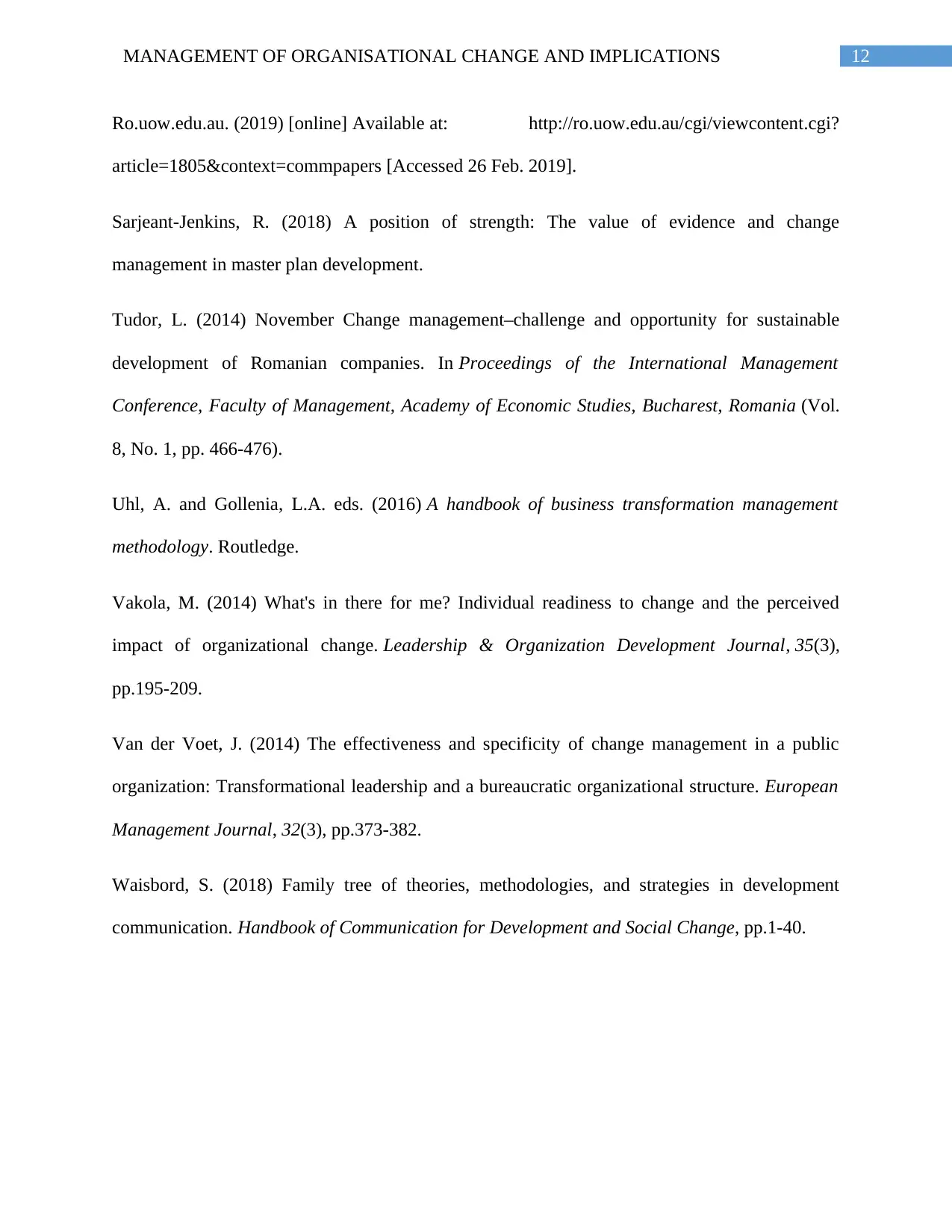
12MANAGEMENT OF ORGANISATIONAL CHANGE AND IMPLICATIONS
Ro.uow.edu.au. (2019) [online] Available at: http://ro.uow.edu.au/cgi/viewcontent.cgi?
article=1805&context=commpapers [Accessed 26 Feb. 2019].
Sarjeant-Jenkins, R. (2018) A position of strength: The value of evidence and change
management in master plan development.
Tudor, L. (2014) November Change management–challenge and opportunity for sustainable
development of Romanian companies. In Proceedings of the International Management
Conference, Faculty of Management, Academy of Economic Studies, Bucharest, Romania (Vol.
8, No. 1, pp. 466-476).
Uhl, A. and Gollenia, L.A. eds. (2016) A handbook of business transformation management
methodology. Routledge.
Vakola, M. (2014) What's in there for me? Individual readiness to change and the perceived
impact of organizational change. Leadership & Organization Development Journal, 35(3),
pp.195-209.
Van der Voet, J. (2014) The effectiveness and specificity of change management in a public
organization: Transformational leadership and a bureaucratic organizational structure. European
Management Journal, 32(3), pp.373-382.
Waisbord, S. (2018) Family tree of theories, methodologies, and strategies in development
communication. Handbook of Communication for Development and Social Change, pp.1-40.
Ro.uow.edu.au. (2019) [online] Available at: http://ro.uow.edu.au/cgi/viewcontent.cgi?
article=1805&context=commpapers [Accessed 26 Feb. 2019].
Sarjeant-Jenkins, R. (2018) A position of strength: The value of evidence and change
management in master plan development.
Tudor, L. (2014) November Change management–challenge and opportunity for sustainable
development of Romanian companies. In Proceedings of the International Management
Conference, Faculty of Management, Academy of Economic Studies, Bucharest, Romania (Vol.
8, No. 1, pp. 466-476).
Uhl, A. and Gollenia, L.A. eds. (2016) A handbook of business transformation management
methodology. Routledge.
Vakola, M. (2014) What's in there for me? Individual readiness to change and the perceived
impact of organizational change. Leadership & Organization Development Journal, 35(3),
pp.195-209.
Van der Voet, J. (2014) The effectiveness and specificity of change management in a public
organization: Transformational leadership and a bureaucratic organizational structure. European
Management Journal, 32(3), pp.373-382.
Waisbord, S. (2018) Family tree of theories, methodologies, and strategies in development
communication. Handbook of Communication for Development and Social Change, pp.1-40.
1 out of 13
Related Documents
Your All-in-One AI-Powered Toolkit for Academic Success.
+13062052269
info@desklib.com
Available 24*7 on WhatsApp / Email
![[object Object]](/_next/static/media/star-bottom.7253800d.svg)
Unlock your academic potential
© 2024 | Zucol Services PVT LTD | All rights reserved.





